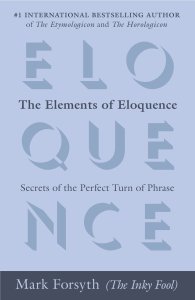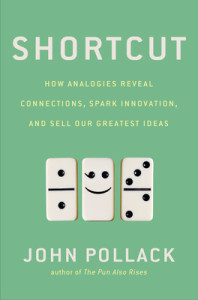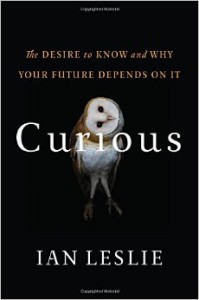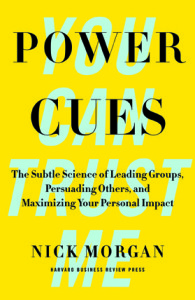 William Shakespeare was perhaps the most eloquent writer in the English language, but according to Mark Forsyth, author of The Elements of Eloquence: Secrets of the Perfect Turn of Phrase
William Shakespeare was perhaps the most eloquent writer in the English language, but according to Mark Forsyth, author of The Elements of Eloquence: Secrets of the Perfect Turn of Phrase, he was not a natural genius. He achieved his eloquence by mastering—through painstaking practice, time and sheer hard work—simple, well-known tools. Well, actually they were well-known tools in his time, because back then students still learned rhetoric in schools. No one learns rhetoric anymore, which is why the world is awash in crap, cliché and corporate communication.
Why do some combinations of words sound so much better than the ordinary? In that previous phrase, everyone will recognize alliteration. I don’t think anyone knows why we like to hear words in succession that start with the same sound, but we do. You may have also recognized the use of tricolon: we like things in threes, especially when the last one is the longest.
Forsyth’s contention is that eloquence is a skill that can be improved by knowledge of the classic elements that were first catalogued by the Greeks and Romans so long ago. It’s like the difference between basic dinner fare and a gourmet meal. An amateur chef can produce a tasty meal, but a professional, with the right ingredients and long experience in combining them just so, can turn out great meals consistently. But eloquence is harder than cooking, because you have to produce a different meal every time you speak or write.
I love this book and strongly endorse it even though it contradicts two of my favorite themes.
The first is that content is king, so my first inclination was to disagree with Forsyth’s other main point: poets succeed not because they express profound ideas, but because they express ordinary ideas exquisitely. But it really is true. Sometimes we hear a phrase that just sounds so right that it’s easy to assume it’s a profound or novel thought. But when you strip away the eloquence and consider the idea, you might find it’s quite ordinary, or even nonsensical. Shakespeare could have said “your dad’s body is thirty feet deep”, but he instead said, “Full fathom five thy father lies.”
Ian Fleming deliberately gave his main character a nondescript name, yet when he said, “Bond. James Bond”, he spoke one of the most memorable lines in movie history. He used diacope, which is a verbal sandwich in which you say a word or phrase, insert an interruption, and then repeat the word or phrase.
It’s easy to assume that I have a suspicion of superficial elements that dress up an untrue or inferior idea. Yet I love a well-turned phrase at least as much as the next person.
There are three ways to read this book. First you have to read it and enjoy it. That’s easy. Then you have to study it. That’s tough but useful. Finally you can practice, practice, practice. (Parataxis with epizeuxis thrown in) You can simply enjoy it, which is easy to do because Forsyth has not only done a great job in compiling examples of the various elements, he has also come up with plenty of his own. You can also study and learn the elements so that you can recognize them when you read or hear them. Don’t worry, it won’t ruin your appreciation of good phrasing—understanding how the effect was created does not make it any less impressive. The third way is to do what Shakespeare did: actively practice. This is risky, as it’s easy to create a lot of crap that just misses the mark, but over time you might just improve the quality of your expression.
The difficulty in writing a review of a book like this is that everything sounds so pedestrian. Anything you write pales in comparison to the greats, so does that mean that one should not aspire to occasional flights of fancy? Is there a place for the elements of eloquence in ordinary business communication, or are they reserved for writers and other creative types? (Rhetorical questions)
I personally believe that while simple, plain and clear expression is perfectly fine most of the time, if you can occasionally slip in something that makes people sit up and take notice, or to repeat what you said afterward, the effects on your personal credibility and reputation may not be to your dissatisfaction. (Litotes) They make you sound smart, the elements do. (Prolepsis)
Hyperbole is something that corporate communication does a lot of, but not well. When everything is awesome or world-class, nothing is. For comparison, note how Dashiel Hammett described the skills of a detective: “(he) could have shadowed a drop of salt water from golden Gate to Hong Kong without ever losing sight of it.”
Another of my themes is the importance of efficiency and concision in speaking and writing, of cutting out unnecessary words, but religiously sticking to that would rule out merism and eliminate lines such as,
“Cannon to right of them,
Cannon to left of them,
Cannon in front of them…”
which could have more concisely said by, “Cannon all around them.”
Of course, King could have shortened his speech by not saying “I have a dream…” so many times. (anaphora)
So, it’s OK to use more words than mere efficiency would dictate, but if that bothers you, you can even out the balance through zeugma (leaving out a verb) or syllepsis (using one word in more than one way), as demonstrated by,
“Sir Edward Hopeless, as guest at Lady Panmore’s ball, complained of feeling ill, took a highball, his hat, his coat, his departure, no notice of his friends, a taxi, a pistol from his pocket, and finally his life. Nice chap. Regrets and all that.”
There are two things this book may do for you–make you a better speaker, or make you a worse speaker. It could be easy to overdo it, or to get so carried away with your own wordcraft that you produce more of the aforementioned crap, which is why you should, when preparing for a speech that is one of the most important of your life, one that will determine the subsequent arc of your personal success, such as a keynote to the 2008 Democratic National Convention, or to your own CFO, who by the way despite her reputation for terseness and brevity is not immune to the power of eloquence, try out your lines on a trusted friend, one who can provide a fresh ear, sounding board, and impartial opinion. (That was hypotaxis, which has probably mercifully gone out of fashion, but was fun to write.)
It’s your choice. You can buy this book and work hard on becoming more eloquent, or you can ignore this and keep producing… (aposiopesis)
 If you’re looking to make your persuasive communications more effective and efficient, a powerful tool is to master the use of analogy, as explained in a delightful book: Shortcut: How Analogies Reveal Connections, Spark Innovation, and Sell Our Greatest Ideas
If you’re looking to make your persuasive communications more effective and efficient, a powerful tool is to master the use of analogy, as explained in a delightful book: Shortcut: How Analogies Reveal Connections, Spark Innovation, and Sell Our Greatest Ideasby John Pollack.
Analogies are like the water that surrounds a fish: we don’t notice them but they are essential to the way we think and communicate. But it’s helpful to pay attention to analogies because they are powerful tools for persuasive communication; they’re essential to the way we think, learn, and react to new information.
Analogies work because our brains are hardwired to learn from experience and to make judgments with as little hard thinking as we can get away with. As we gain experience in the world, we build mental models of what works or doesn’t work, and what is good or bad. So whenever we encounter new information, we try to make sense of it by comparing it to something familiar. In essence, we choose an appropriate analogy from our vast internal database—usually instantly and unconsciously—and that colors how we react to the new information. Because there can be many familiar situations that might apply, the persuader who chooses the analogy for us creates an easy shortcut for us to take. An astute persuader chooses the best analogy; he does not leave the choice up to the recipient.
According to Pollack, there are five ways that analogies affect the persuasiveness of your ideas:
- Like a native guide in a strange land, they use the familiar to explain the unfamiliar. This is the most obvious function of analogy, and it’s particularly useful in reducing the perceived risk of new ideas.
- Like magicians who direct your attention for maximum effect, they highlight some things and hide others. They help you frame your message in the best possible light.
- They identify useful abstractions and make them concrete so that we can grasp and remember them easier. When FDR faced the difficult task of selling the American people on providing aid to Britain through Lend-Lease, he compared it to lending your neighbors your garden hose when their house is on fire.
- They tell a coherent story. In fact, an analogy is a distilled form of a story, and most stories are just extended analogies.
- They resonate emotionally. The feelings associated with the familiar transfer over to the new.
Analogies are subtle; they’re like the spoonful of sugar which makes it easier to swallow a difficult message—they help you bypass the normal reaction that people have against being told what to do. Analogies are vivid, which helps people remember your key points later on when they use the information you’ve provided to make their decision.
Most of all, analogies are powerful; once they’ve taken hold, they’re difficult to eradicate. It’s true that people who disagree with you may dispute your analogy, but there is definitely a first-mover advantage: if the analogy resonates, it’s difficult to fight it, even when they can point out flaws. An excellent example described in the book was used by John Roberts during his Senate hearings when he was nominated for Chief Justice. Roberts knew that Democratic Senators would challenge his fairness, so he opened by comparing himself to a baseball umpire; his point was that an umpire does not make the rules, he enforces them, and he does so fairly and impartially. Although then-Senator Biden pointed out that as Chief Justice, he would in fact be the one making the rules, the analogy had already taken hold. (If your opponent gets their analogy out first, it’s usually not enough to refute it. You have to fight fire with fire and come up with a better analogy of your own.)
The John Roberts example is just one of dozens that Pollack recounts in the book and which make it a pleasure to read. Read this book and you will be better able to tap into hidden superpowers of persuasion you might not even know you have.
 Piggybacking off last week’s article about personal renewal and the importance of staying curious, I would like to recommend Curious: The Desire to Know and Why Your Future Depends On It
Piggybacking off last week’s article about personal renewal and the importance of staying curious, I would like to recommend Curious: The Desire to Know and Why Your Future Depends On It. Why should a blog dedicated to persuasive communication care about a book on curiosity? I guess you’ll have to read the rest of this to find out…
For starters, being curious makes you easier to talk to. Actually caring enough to want to know about the other person is what gets us to ask questions and thus use our ears more than our mouths. Curiosity focuses attention and shows caring… If you want to be interesting to other people, show an interest in them; when you’re curious about them, and about the things that they care about, you will find that they will talk to you at length.
That’s called empathic curiosity, by the way, and it’s one of the three forms of curiosity that Leslie describes in his book.
Empathic curiosity is a key quality for successful salespeople as well. It’s the central ingredient in outside-in thinking, in which you strive to get what you want by helping the other person get what they want. You can find out a lot about the other person because it’s part of your job, or you can be intrinsically curious about who they are and what makes them tick—and people can tell the difference.
Besides showing you care, your curiosity is what prompts you not to accept the easy, surface answers, and to dig deeper into situations—to ask why with the tenacity of a four-year-old until you get to the real issues. This can be extremely useful in consultative selling, and especially in negotiations, where the ability to understand others’ perspectives can help uncover their true interests behind their declared positions.
Persuasion also depends to a large extent on having something useful or important to say, and that requires a mind filled with knowledge about the world, which you can only get if you are truly and deeply curious about how things work and how people think. This is called epistemic curiosity, and it’s the mechanism that drives us to learn for the sake of learning. Epistemic curiosity built our modern world because it led humans to explore outside the safety of their fire, to sail out of sight of land, and to question what the authorities called wisdom.
Epistemic curiosity is what the book is mostly about. It’s what drives us to dig deep into the details and nuances of a topic. The big difference between epistemic curiosity and the shallower sort is that it requires effort, and that effort is repaid through deeper learning and greater understanding. Of course, when you’re truly curious, the effort is not work, it is joy. It’s also curiosity with a specific direction, where you are in control of your own effort and learning, not pulled along by the latest shiny distraction that comes your way.
However, curiosity is not all good. While it may not kill you, it can certainly kill your productivity. The form of curiosity that fills your otherwise productive time is diversive curiosity, and unfortunately it’s probably the most common. It’s what attracts us to novelty; it’s shallow and strives for instant gratification. Unlike epistemic curiosity, diversive curiosity controls you. As Leslie tells us, imagine what you would tell someone from fifty years ago about the future:
“I possess a device, in my pocket, that is capable of accessing the entirety of information known to man. I use it to look at pictures of cats and get into arguments with strangers.”
It doesn’t have to be that way. The internet can make you smarter or dumber, depending on how you use it. Be careful what you put in your mind. Just as you are what you eat; you are what you read.
Curious is a fascinating blend of history and science. Chapter 2 explores the development—or lack thereof—of curiosity in children. Kids ask up to 100 questions per hour. Until about 30 months, their questions focus on what and where, and then they move on to why and how questions. Curiosity continues to flourish when adults answer the question and engage them with questions of their own, and dies when they don’t.
For me, the best chapter is the one in which Leslie demolishes the trendy idea that we don’t have to learn anything deeply anymore because we can Google it. We’re told that it’s more important to think critically and be creative than to stuff our minds with facts. The problem is that critical thinking and creativity require a deep database, because that’s the only way our mind can make the meaningful connections. In his words, ”Creativity starts in combination”, and you need a lot of useful information in your mind to make the necessary combinations.
Today we’re in the Age of Answers. The thing about Google is that it is very good at finding answers to things you specifically want to know, but it’s terrible at helping you stumble across things you don’t even know yet that you want to know more about.
The benefit of building your store of knowledge is why, according to recent research cited in this book, curiosity may be as important to success as intelligence and grit. It provides the intrinsic motivation to learn that keeps you engaged. To the curious, every day and every encounter is a new opportunity for growth.
Fortunately, curiosity is a state, not a trait. This means you can increase your general level of curiosity. Leslie provides seven suggestions.
7 ways to stay curious:
Stay foolish: don’t let success quench your curiosity.
Build the database: Facts are not separate bits of knowledge, they are nodes in a network of knowledge. “knowledge loves knowledge”.
Forage like a foxhog: Is it better to have deep or broad knowledge? Leslie’s take on the comparisons between hedgehogs and foxes is that you need t-shaped knowledge: deep in one area combined with breadth.
Ask the big Why. Understanding others’ motivations will make you a better negotiator and influencer.
Be a thinkerer. Ideas are nothing without hard work to make them come to fruition. Thinking and action have to go together, so you need both the big picture and the small details.
Question your teaspoons. Anything can be interesting if you study it closely enough.
Turn puzzles into mysteries. Turn puzzles into mysteries. Puzzles can lose their interest when solved. Mysteries can intrigue forever.
Well-researched and well-written, Curious is a fascinating book, which I strongly recommend[1].
[1] The only thing I did not like is the poor quality of the citations, because they make it difficult for those of us who are curious to dig even deeper into the topic.
 Nick Morgan has written two very good books on presentations and persuasive communications[1], so I looked forward to reading his new book, Power Cues: The Subtle Science of Leading Groups, Persuading Others, and Maximizing Your Personal Impact
Nick Morgan has written two very good books on presentations and persuasive communications[1], so I looked forward to reading his new book, Power Cues: The Subtle Science of Leading Groups, Persuading Others, and Maximizing Your Personal Impact. For the most part, I was not disappointed. The book contains a lot of solid material which can definitely help anyone who wants to strengthen their skills and boost their personal influence.
Everyone can get something different out of this book, depending on their baseline level of knowledge of nonverbal communication. Without false modesty, I can say that I have read dozens of books and hundreds of articles on the topic, including almost all of his principal sources. But I also learned a lot, because Morgan supplements the research by incorporating it into his own system based on his long experience. It’s obvious that he knows what he’s talking about and what he’s doing.
The theme of the book is that your unconscious mind is hugely influential in your perceptions and decisions, and you can become a better communicator by gaining control over your own cues and becoming more skilled at reading others.
There are seven power cues, each covered in its own chapter. I personally found the first two the most useful: becoming self-aware of how you present yourself to others and then taking charge of your nonverbal communication. One excellent point is that “charisma is focused emotion”, but because it’s almost impossible to focus on your material and your own body language at the same time, you need to put yourself into the right state of mind before that important meeting or big presentation, and the book describes techniques that method actors use before they go on stage.
The third chapter concerns reading the signals of others. Morgan pays lip service to Paul Ekman’s work on micro-expressions, but then sensibly tells us that it’s too complicated to use in normal situations. Morgan’s key insight is that we are already experts in reading nonverbal cues, but we don’t always know how to tap into that knowledge. His approach is to teach you how to listen to your unconscious mind by asking yourself four fundamental questions: Is this person: friend or foe? Telling the truth? On my side? Powerful or not?
After the first three chapters, the book became less useful to me, but that may just be a personal reaction. Chapter four concerns the proper use of your voice. It’s no great revelation that deeper voices are perceived as more powerful, but there is not too much that you can do about it. You can work on your breathing, or you can use a piano to find your “maximum resonance point” (and I have to admit I got totally lost on that one).
Chapter 5 goes deeper into the combination of body language and voice, using the framework from the book, Honest Signals, by Sandy Pentland. I find some of the suggestions a bit gimmicky, especially the idea of trying to manipulate others by mirroring their movements, but there are some good ideas in here.
Chapter 6 made me scratch my head a bit, trying to figure out how it fits in with the rest of the book. It’s about using self-affirmation to harness the power of your unconscious mind.
Chapter 7 is about using stories to really connect with your audiences. This chapter is very practical, with excellent suggestions on how to structure and tell stories. It’s a nice strong finish to the book.
Will this book make you a better communicator? Maybe – it depends on you. I have two caveats. The first is one that Morgan himself issues in the book: these are subtle and difficult skills that require practice to master. You can’t become an instant expert just by reading about a new technique, any more than you can shoot a basketball better because you watched Lebron James on TV last night. Second, you always have to keep in mind that cues don’t trump content in the long run. In fact, if you have strong content backed by solid evidence, you will probably radiate these cues naturally.
Despite my reservations, I still give the book five stars because I believe that regardless of where you start from, there are plenty of practical ideas in this book to make you a more persuasive communicator. Read it, choose the ideas that you think will work for you, and then practice, practice, practice!
[1] Give Your Speech, Change the World: How to Move Your Audience to Action, and Trust Me: Four Steps to Authenticity and Charisma


